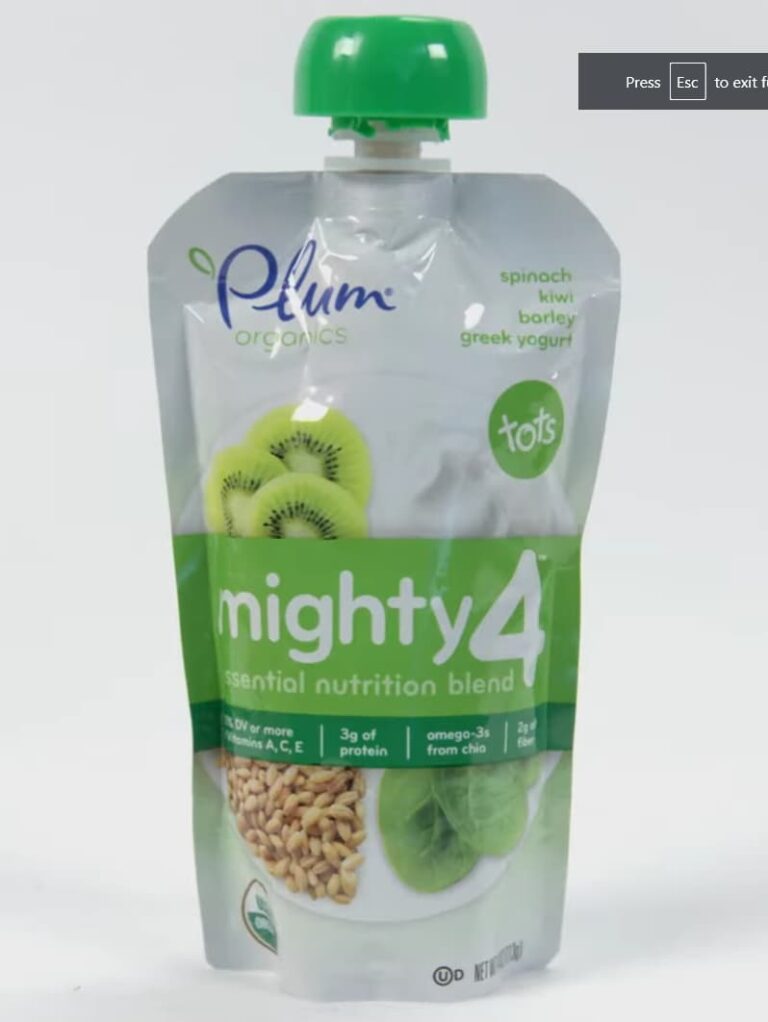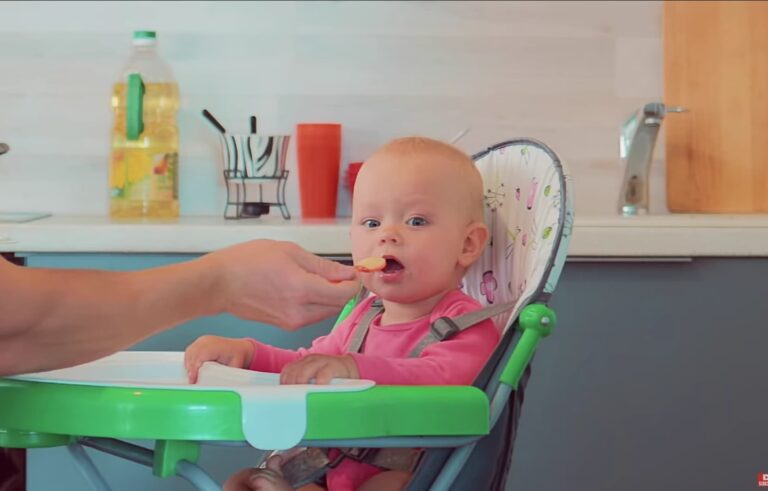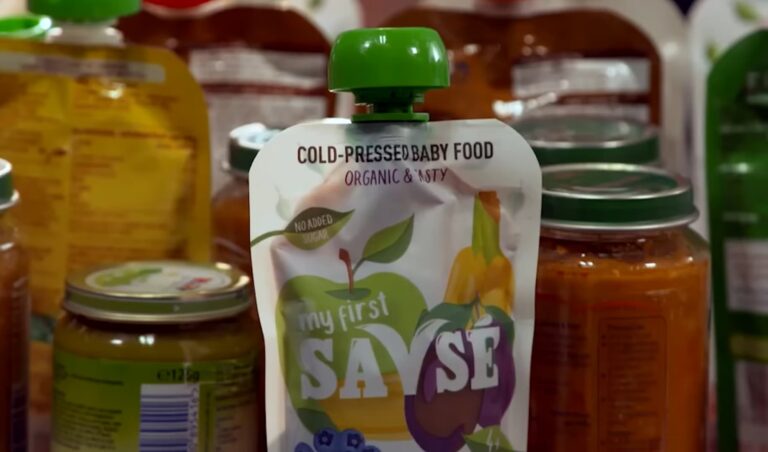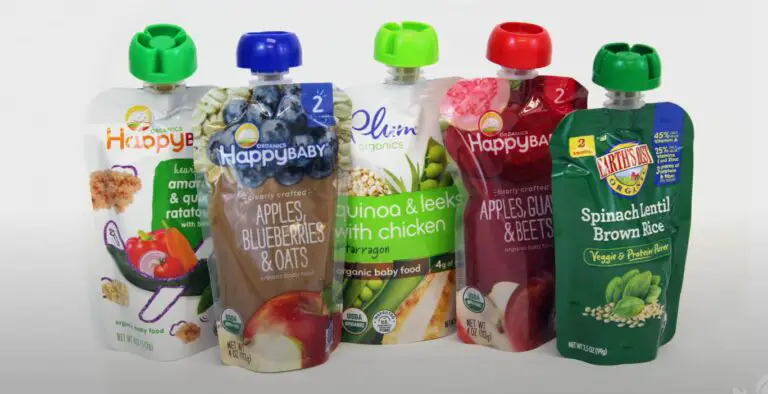When can babies eat baby food?
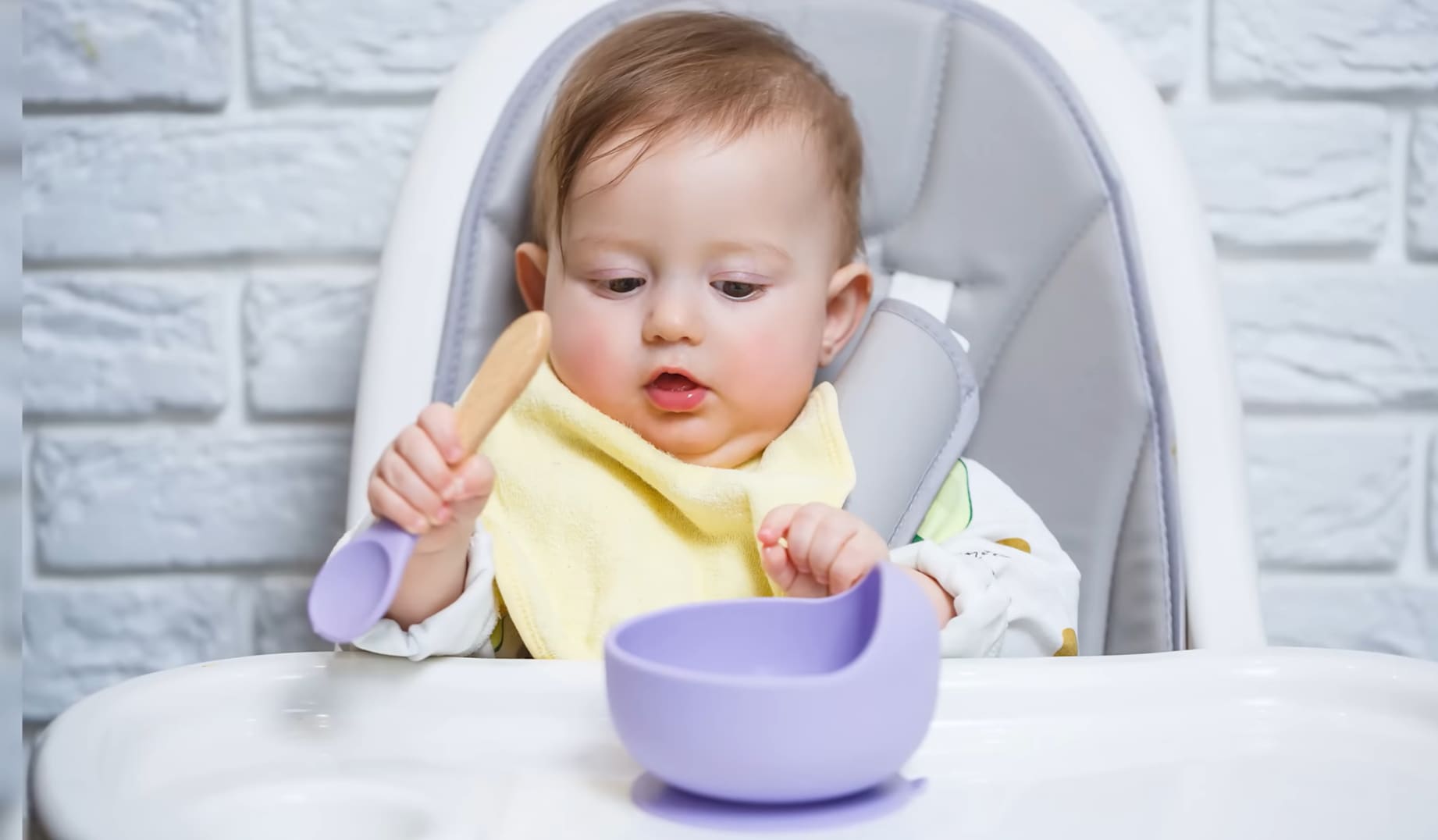
Babies can start eating baby food at around six months old. Introducing solid foods to your baby is an exciting milestone in their development.
So, when a baby is about six months old, they can start trying new tastes! Just like when you try a new ice cream flavor. But, instead of ice cream, they get mashed or chopped-up foods because their tummies are still tiny.
But hey, every baby is different, like you and your friends! So, it’s super important for moms and dads to talk to the baby’s doctor before giving them new foods. The doctor knows what’s best for each little one!
We’re gonna talk about when a baby is ready to try these new foods, what yummy options they have, and some rules to make sure the baby is happy and healthy during snack time!
Remember, we’re keeping it simple and fun, just like playing with building blocks!
Introducing Solids To Babies
Introducing new foods to your baby is like opening a treasure box of flavors! It’s a big step from just having milk. It’s super important for moms and dads to know when their little explorer is ready for this adventure and how to make it fun and easy.
In this blog, we’re going to look at what people used to believe and what experts say now about giving babies their first solid foods. We’ll also talk about the little signs that show your baby is ready to try new foods and give you some tips on how to switch from milk to solids.
Traditional Belief and Current Recommendations
Feeding babies has changed over time. A long time ago, parents used to give their babies solid foods when they were 4 months old. But now, experts, at the American Academy of Pediatrics say it’s better to wait until babies are about 6 months old to start giving them solid foods.
This change is because we know more about how babies’ digestive systems work and when they’re ready for real food. Waiting until 6 months helps babies handle solid food better, and it also lowers the chances of them having some health problems or allergies.
Transitioning from Breast Milk / Formula to Solid Foods
The transition from breast milk or formula to solid foods should be gradual and done with care. Here are some steps to consider for a smooth transition:
- Start with single-ingredient purees: Begin by introducing simple and easy-to-digest purees, such as mashed bananas or steamed carrots. This allows your baby to get used to new flavors and textures.
- Offer one food at a time: Introduce new foods one at a time, waiting a few days before introducing another. This helps you identify any potential allergies or reactions.
- Gradually increase texture and variety: As your baby becomes more comfortable with purees, you can begin to introduce thicker textures and a wider variety of foods. This helps develop their chewing and swallowing skills.
- Encourage self-feeding: As your baby grows, encourage them to feed themselves by offering soft finger foods or small, age-appropriate pieces of food.
Remember, patience and persistence are key during this transition phase. It’s normal for babies to be hesitant or make funny faces when trying new foods. Keep offering a variety of healthy options and allow your little one to explore at their own pace.
By following these recommendations and watching for signs of readiness, you can ensure a positive experience as your baby begins their journey into the world of solid foods. Enjoy this exciting milestone together and savor every messy, food-filled moment!
Age Guidelines For Introducing Baby Food
Introducing solid foods to your baby is an interesting moment but it is important to maintain some age guidelines in order to keep them healthy. It is important to consult with a pediatrician about the specific needs of your baby. By the way, to help you in this progress, we have made some suggestions, which will help you most from the beginning!
General timeline for introducing solids
Introducing baby food follows a general timeline based on your child’s age and developmental readiness. Keep in mind that these age ranges are approximate, and it’s essential to observe your baby for signs of readiness before introducing solids.
6-8 months: Expanding the variety of foods
Between 6 and 8 months, your baby’s development will progress, paving the way for a broader range of foods. Look for these signs of readiness:
- Ability to sit without support, maintaining a good balance
- Development of the pincher grasp, enabling them to pick up small objects
- Showing interest in finger foods and reaching for items on the table
During this stage, you can introduce pureed fruits, vegetables, and pureed meats. Gradually offer a variety of flavors and textures to stimulate their taste buds and encourage proper chewing development.
8-12 months: Progression to more complex textures
As your baby approaches the first year, they will be ready for more complex textures and self-feeding. Look for these signs of readiness:
- Ability to chew and mash foods with their gums
- Interest in feeding themselves with their fingers or an infant-feeding spoon
- Increased coordination and fine motor skills
At this stage, you can introduce soft-cooked vegetables, small pieces of soft fruits, mashed grains, and finely chopped or shredded meats. Encourage self-feeding by offering nutritious finger foods that are easy to pick up and hold.
Remember, these age guidelines are approximate, and each baby develops at their own pace. Always pay attention to your baby’s cues and consult with your pediatrician for personalized guidance on introducing baby food.
Recognizing Developmental Milestones
Recognizing when babies are ready to start eating baby food is an important milestone in their development. Introducing solid foods into their diet marks a crucial step towards their growth and nourishment. However, it’s essential to pay attention to certain physical, cognitive, and motor skills that indicate when babies are ready for this transition. By identifying these developmental milestones, you can ensure that your little one embarks on their journey of exploring new flavors and textures at the right time.
Physical and Cognitive Signs of Readiness
Before introducing baby food, it’s important to observe physical and cognitive signs that indicate readiness. Here are a few significant cues that your baby might be ready to take their first bites:
- Increased head control: Babies should be able to hold their heads upright and steady without support.
- Loss of tongue-thrust reflex: The tongue-thrust reflex, in which babies push food out of their mouth with their tongue, usually disappears around the age of four to six months.
- Ability to sit with minimal support: Your baby should be able to sit up with just a little assistance, maintaining good balance and control.
- Showing interest in your food: If your baby starts watching you intently during meal times or reaching for your plate, they may be displaying curiosity and willingness to try new foods.
Motor Skills Required for Eating Baby Food
Along with the physical signs of readiness, certain motor skills are necessary for babies to successfully eat baby food. These skills help them coordinate their mouth and hands, enabling them to eat safely and with minimal risk of choking. Here are some key motor skills to watch out for:
- Tongue movement: Babies should be able to move their tongues back and forth and manipulate food within their mouths.
- Pincer grasp: The ability to pick up small objects between the thumb and forefinger indicates that babies have the dexterity needed to grasp and self-feed.
- Biting and chewing: Babies should be able to bite and chew soft textures, progressively transitioning from sucking to more advanced feeding techniques.
Importance of Sitting Up Independently
Sitting up independently is an essential milestone before babies start eating baby food. When babies can sit upright unassisted, it ensures they have the necessary core stability, head control, and overall strength to handle solid foods. Here’s why independent sitting is crucial:
- Prevents choking hazards: When babies sit up unsupported, they can maintain an upright position, reducing the risk of choking while eating.
- Promotes self-feeding: Sitting up independently allows babies to explore and interact with their food, helping them develop self-feeding skills, independence, and a positive relationship with food.
- Enhances digestion: The upright position aids digestion by allowing the food to travel smoothly through the digestive system.
By recognizing these developmental milestones, you can ensure that your baby is ready for the exciting journey of exploring new tastes and textures. Remember, every baby develops at their own pace, so it’s essential to monitor their signs of readiness and consult with your pediatrician for personalized guidance.
Safe Feeding Practices
Now It’s time to focus on safe feeding. Safe feeding practices can reduce the risk of any potential danger to your baby. In this article, we will discuss some key points to keep in mind when feeding your baby solid foods.
Appropriate Feeding Utensils and Equipment
Using the right equipment can make a significant difference in the safety and comfort of your baby during mealtimes. Here are some important considerations:
- Start by choosing a high-quality, BPA-free feeding spoon that is soft and gentle on your baby’s delicate gums. Opt for a spoon made from silicone or rubber materials.
- In addition to a spoon, you may also want to invest in a baby bowl with a suction feature to prevent accidental spills or tipping.
- When your baby is ready to drink from a cup, select a training cup with handles and a spill-proof lid. This will make it easier for your baby to grasp and drink independently.
- It’s important to regularly inspect all feeding utensils and equipment for any signs of damage or wear and tear. Replace anything that may pose a risk to your baby’s safety.
Supervision During Mealtime
Supervision is crucial during your baby’s mealtime. Here are some guidelines to follow:
- Always stay within arm’s reach of your baby while they are eating. This way, you can quickly respond if they experience any difficulties or show signs of choking.
- Eliminate distractions during mealtimes, such as phones or TVs, to ensure your full attention is on your baby.
- Observe your baby’s feeding cues and adjust the pace accordingly. Let them guide you to know when they are hungry or full.
- Be patient and encourage self-feeding as your baby grows older. This will help them develop their fine motor skills and independence.
- Remember to create a calm and pleasant environment during mealtimes. This will establish positive associations with food and eating for your baby.
Preventing Choking Hazards
Choking is a serious hazard when introducing solid foods to your baby. Take the following instructions to minimize the risk:
- If possible, mash the food to a smooth texture before giving your baby. This will reduce the chances of them choking on large chunks.
- Avoid giving your baby hard, round, or small foods that can easily get lodged in their throat. Examples include whole grapes, nuts, popcorn, and chunks of raw vegetables.
- Cut food into small, manageable pieces to make it easier for your baby to eat.
- Always closely monitor your baby while they are eating and be prepared to administer first aid in case of a choking emergency.
By following these safe feeding practices, you can create a nurturing and secure environment for your baby to explore new tastes and textures. Remember to consult with your pediatrician for personalized guidance based on your baby’s individual needs and development.
Recognizing Developmental Milestones
Recognizing when babies are ready to start eating baby food is an important milestone in their development. Introducing solid foods into their diet marks a crucial step towards their growth and nourishment. However, it’s essential to pay attention to certain physical, cognitive, and motor skills that indicate when babies are ready for this transition. By identifying these developmental milestones, you can ensure that your little one embarks on their journey of exploring new flavors and textures at the right time.
Physical and Cognitive Signs of Readiness
Before introducing baby food, it’s important to observe physical and cognitive signs that indicate readiness. Here are a few significant cues that your baby might be ready to take their first bites:
- Increased head control: Babies should be able to hold their heads upright and steady without support.
- Loss of tongue-thrust reflex: The tongue-thrust reflex, in which babies push food out of their mouth with their tongue, usually disappears around the age of four to six months.
- Ability to sit with minimal support: Your baby should be able to sit up with just a little assistance, maintaining good balance and control.
- Showing interest in your food: If your baby starts watching you intently during meal times or reaching for your plate, they may be displaying curiosity and willingness to try new foods.
Motor Skills Required for Eating Baby Food
Along with the physical signs of readiness, certain motor skills are necessary for babies to successfully eat baby food. These skills help them coordinate their mouth and hands, enabling them to eat safely and with minimal risk of choking. Here are some key motor skills to watch out for:
- Tongue movement: Babies should be able to move their tongues back and forth and manipulate food within their mouths.
- Pincer grasp: The ability to pick up small objects between the thumb and forefinger indicates that babies have the dexterity needed to grasp and self-feed.
- Biting and chewing: Babies should be able to bite and chew soft textures, progressively transitioning from sucking to more advanced feeding techniques.
Importance of Sitting Up Independently
Sitting up independently is an essential milestone before babies start eating baby food. When babies can sit upright unassisted, it ensures they have the necessary core stability, head control, and overall strength to handle solid foods. Here’s why independent sitting is crucial:
- Prevents choking hazards: When babies sit up unsupported, they can maintain an upright position, reducing the risk of choking while eating.
- Promotes self-feeding: Sitting up independently allows babies to explore and interact with their food, helping them develop self-feeding skills, independence, and a positive relationship with food.
- Enhances digestion: The upright position aids digestion by allowing the food to travel smoothly through the digestive system.
By recognizing these developmental milestones, you can ensure that your baby is ready for the exciting journey of exploring new tastes and textures. Remember, every baby develops at their own pace, so it’s essential to monitor their signs of readiness and consult with your pediatrician for personalized guidance.
Safe Feeding Practices
Now It’s time to focus on safe feeding. Safe feeding practices can reduce the risk of any potential danger to your baby. In this article, we will discuss some key points to keep in mind when feeding your baby solid foods.
Appropriate Feeding Utensils and Equipment
Using the right equipment can make a significant difference in the safety and comfort of your baby during mealtimes. Here are some important considerations:
- Start by choosing a high-quality, BPA-free feeding spoon that is soft and gentle on your baby’s delicate gums. Opt for a spoon made from silicone or rubber materials.
- In addition to a spoon, you may also want to invest in a baby bowl with a suction feature to prevent accidental spills or tipping.
- When your baby is ready to drink from a cup, select a training cup with handles and a spill-proof lid. This will make it easier for your baby to grasp and drink independently.
- It’s important to regularly inspect all feeding utensils and equipment for any signs of damage or wear and tear. Replace anything that may pose a risk to your baby’s safety.
Supervision During Mealtime
Supervision is crucial during your baby’s mealtime. Here are some guidelines to follow:
- Always stay within arm’s reach of your baby while they are eating. This way, you can quickly respond if they experience any difficulties or show signs of choking.
- Eliminate distractions during mealtimes, such as phones or TVs, to ensure your full attention is on your baby.
- Observe your baby’s feeding cues and adjust the pace accordingly. Let them guide you to know when they are hungry or full.
- Be patient and encourage self-feeding as your baby grows older. This will help them develop their fine motor skills and independence.
- Remember to create a calm and pleasant environment during mealtimes. This will establish positive associations with food and eating for your baby.
Preventing Choking Hazards
Choking is a serious hazard when introducing solid foods to your baby. Take the following instructions to minimize the risk:
- If possible, mash the food to a smooth texture before giving your baby. This will reduce the chances of them choking on large chunks.
- Avoid giving your baby hard, round, or small foods that can easily get lodged in their throat. Examples include whole grapes, nuts, popcorn, and chunks of raw vegetables.
- Cut food into small, manageable pieces to make it easier for your baby to eat.
- Always closely monitor your baby while they are eating and be prepared to administer first aid in case of a choking emergency.
By following these safe feeding practices, you can create a nurturing and secure environment for your baby to explore new tastes and textures. Remember to consult with your pediatrician for personalized guidance based on your baby’s individual needs and development.

